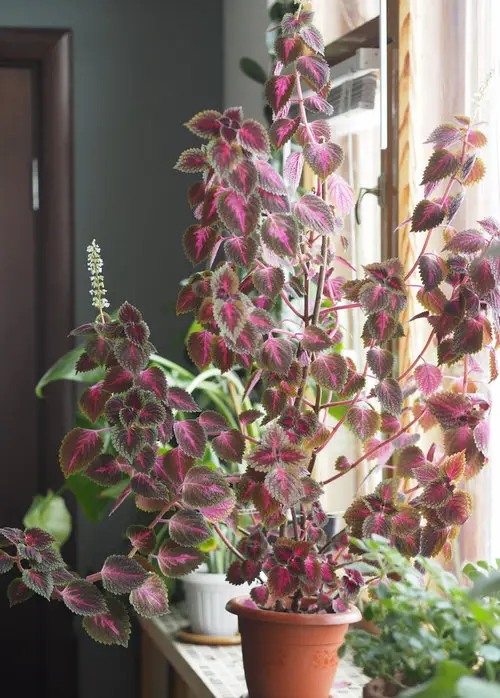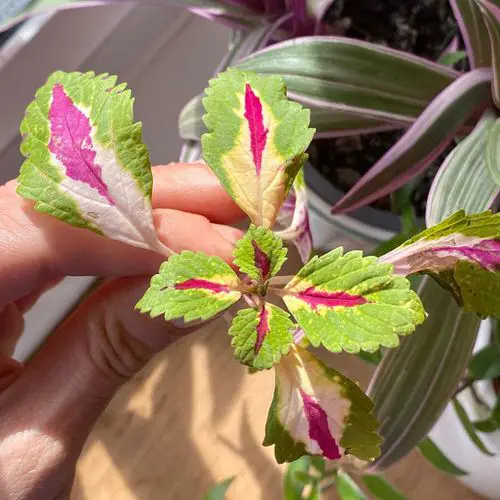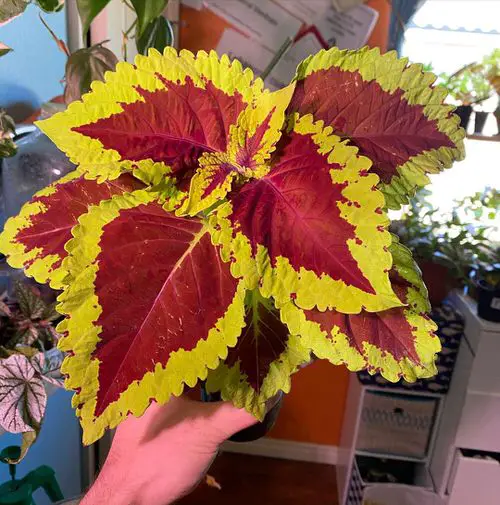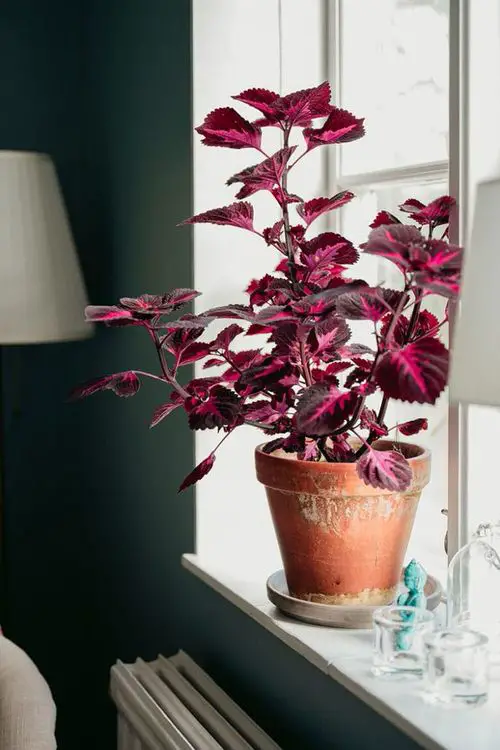Want to know How to Grow Coleus as a Houseplant? Well, it’s easy and quite a bit of fun! We have all the details and information for you.

Growing painted nettle is a great choice if you want a plant that adds a palette of color to your semi-indoor space. It is one of the best plants to have on a patio, porch, or balcony that’s attached to your room. Let’s have a look at How to Grow Coleus as a Houseplant.
Have a look at some stunning Indoor Coleus pictures here
Best Coleus Varieites
Primarily native to Asia, there are more than 60 subspecies of Coleus. However, all varieties are derived from the Plectranthus scutellarioides species and are crossed with others.
Some popular coleus varieties include Wizard Mix, Stained Glassworks Kiwi Fern, Fishnet Stockings, Black Dragon, Trailing Plum, Rustic Orange, Henna, Limelight, and more.
Check out our article on the Best Coleus Varieties to Grow here
Best Pot Size for Growing Coleus as a Houseplant

The size of the pot depends mainly on the size of the plant. If you have bought a new specimen from a nursery, then re-pot it into just one size bigger container than the older one. For starters and new plants, a 5 to 8 inches pot should be fine.
You can also grow coleus in hanging baskets and creative pots in macrame holders!
Here’s a quick tip to help you with choosing the pot size for your plants
Propagating Coleus

To propagate the Coleus plant via stem cuttings, follow these steps carefully:
- Snip 5-6 inches long stem, just above a leaf node, from a healthy plant.
- Remove the leaves at the bottom while keeping the upper ones intact.
- Now plant the cutting in a potting mix, water well, and keep it in bright and indirect light.
- It takes 2-4 weeks for the cuttings to grow roots.
You can also grow the cuttings in water. Keep it in a vase filled with non-chlorinated water in bright indirect light. Change the water once in 4-6 days. The cuttings will form roots in 3-5 weeks.
Coleus can also be grown from seeds too, which is also not difficult, but if you’re a beginner, it is better to buy some healthy transplants from a garden center. Later on, you can multiply them from stem cuttings!
Check out our detailed article on how to grow coleus from cuttings here
Requirements to Grow Coleus as a Houseplant

Position
Coleus is not an ideal low-light houseplant, so place it on a bright windowsill or near a glass door, or locate a spot that receives indirect light. It’s also perfect for porches and shady balconies.
If growing in a cool climate, where the sun is mild, it would be best if the plant has access to 2-4 hours of direct sun for its colorful leaves.
While coleus can tolerate the direct sun, the intense heat of the afternoon can burn and fade its delicate, vibrant leaves. So, make sure you keep it a little away from a south-facing window.
Soil
The plant is not much fussy about the growing medium and won’t even mind regular garden soil. For best growth, however, use a good quality and well-draining potting mix. You can also add a bit of vermiculite or perlite to the growing medium for drainage.
Water
Coleus loves to grow in a slightly moist growing medium and wilts quickly if the soil dries out completely. So, keep the soil evenly moist by watering the plant thoroughly, but only when the topsoil feels a bit dry to the touch (if growing indoors).
You’ll have to create a perfect balance between when should you water and when should you not–to keep your indoor coleus growing. Also, avoid moistening the plant daily, as it will cause root rot and attract fungal issues.
Temperature
Coleus is comfortable in a temperature range of 50-95 F or 10-35 C. When growing indoors, keep the plant away from A/C and heating vents or sudden temperature fluctuations.
Humidity
Coleus grows easily in medium humidity, unlike some other finicky houseplants that demand high humidity. In drier months, you can follow these measures to increase humidity for your coleus plant.
Learn how to make pebble trays for your houseplants here
Coleus Care
If you want your coleus to grow old and bigger, and it really grows for more than one season–it is suggested to repot the plant in a bigger pot, trim the terminal buds and remove its flowers, if any. Removing coleus flowers regularly is the most important task otherwise, the plant looks tired and less vigorous.

Fertilizer
Though fertilizing heavily is not necessary, you can boost the growth by applying balanced liquid fertilizer in a weak dose of 1/4 of the recommended strength once in 2 weeks.
Note: Do not fertilize during the winter months if you live in a cold climate.
Pests & Diseases
Like any other houseplant, Coleus is also prone to aphids, spider mites, and mealybugs. Use an insecticidal soap solution to knock them off. The most common pests that bother them are whiteflies and mites.
The best way to keep the plant safe from potential diseases is never to overwater it. Also, make sure it gets good ventilation.


